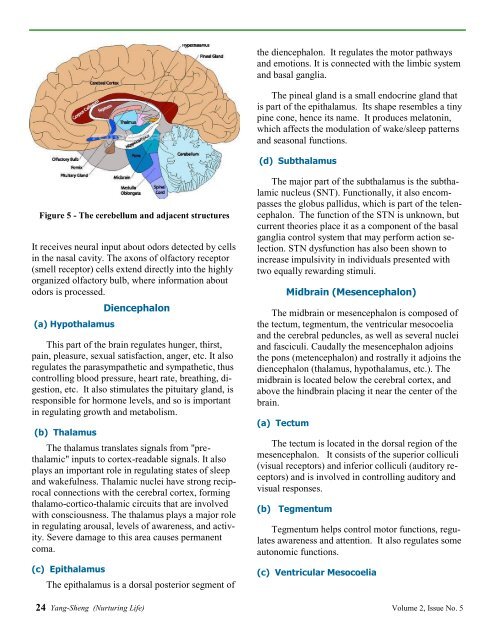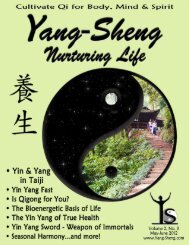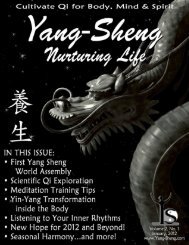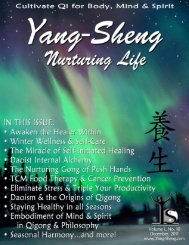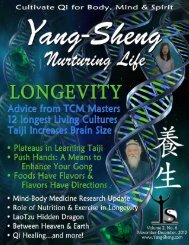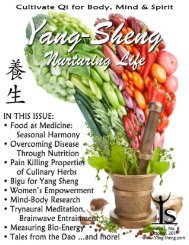Download - Yang-Sheng
Download - Yang-Sheng
Download - Yang-Sheng
Create successful ePaper yourself
Turn your PDF publications into a flip-book with our unique Google optimized e-Paper software.
the diencephalon. It regulates the motor pathways<br />
and emotions. It is connected with the limbic system<br />
and basal ganglia.<br />
The pineal gland is a small endocrine gland that<br />
is part of the epithalamus. Its shape resembles a tiny<br />
pine cone, hence its name. It produces melatonin,<br />
which affects the modulation of wake/sleep patterns<br />
and seasonal functions.<br />
(d) Subthalamus<br />
Figure 5 - The cerebellum and adjacent structures<br />
It receives neural input about odors detected by cells<br />
in the nasal cavity. The axons of olfactory receptor<br />
(smell receptor) cells extend directly into the highly<br />
organized olfactory bulb, where information about<br />
odors is processed.<br />
(a) Hypothalamus<br />
Diencephalon<br />
This part of the brain regulates hunger, thirst,<br />
pain, pleasure, sexual satisfaction, anger, etc. It also<br />
regulates the parasympathetic and sympathetic, thus<br />
controlling blood pressure, heart rate, breathing, digestion,<br />
etc. It also stimulates the pituitary gland, is<br />
responsible for hormone levels, and so is important<br />
in regulating growth and metabolism.<br />
(b) Thalamus<br />
The thalamus translates signals from "prethalamic"<br />
inputs to cortex-readable signals. It also<br />
plays an important role in regulating states of sleep<br />
and wakefulness. Thalamic nuclei have strong reciprocal<br />
connections with the cerebral cortex, forming<br />
thalamo-cortico-thalamic circuits that are involved<br />
with consciousness. The thalamus plays a major role<br />
in regulating arousal, levels of awareness, and activity.<br />
Severe damage to this area causes permanent<br />
coma.<br />
(c) Epithalamus<br />
The epithalamus is a dorsal posterior segment of<br />
The major part of the subthalamus is the subthalamic<br />
nucleus (SNT). Functionally, it also encompasses<br />
the globus pallidus, which is part of the telencephalon.<br />
The function of the STN is unknown, but<br />
current theories place it as a component of the basal<br />
ganglia control system that may perform action selection.<br />
STN dysfunction has also been shown to<br />
increase impulsivity in individuals presented with<br />
two equally rewarding stimuli.<br />
Midbrain (Mesencephalon)<br />
The midbrain or mesencephalon is composed of<br />
the tectum, tegmentum, the ventricular mesocoelia<br />
and the cerebral peduncles, as well as several nuclei<br />
and fasciculi. Caudally the mesencephalon adjoins<br />
the pons (metencephalon) and rostrally it adjoins the<br />
diencephalon (thalamus, hypothalamus, etc.). The<br />
midbrain is located below the cerebral cortex, and<br />
above the hindbrain placing it near the center of the<br />
brain.<br />
(a) Tectum<br />
The tectum is located in the dorsal region of the<br />
mesencephalon. It consists of the superior colliculi<br />
(visual receptors) and inferior colliculi (auditory receptors)<br />
and is involved in controlling auditory and<br />
visual responses.<br />
(b) Tegmentum<br />
Tegmentum helps control motor functions, regulates<br />
awareness and attention. It also regulates some<br />
autonomic functions.<br />
(c) Ventricular Mesocoelia<br />
24 <strong>Yang</strong>-<strong>Sheng</strong> (Nurturing Life) Volume 2, Issue No. 5


